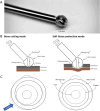Evaluation of a novel high speed burr tip for safe and efficient bone surgery in a sheep model
- PMID: 40374750
- PMCID: PMC12081626
- DOI: 10.1038/s41598-025-01769-7
Evaluation of a novel high speed burr tip for safe and efficient bone surgery in a sheep model
Abstract
The exposure of neural structures by removing the overlying bone using a high-speed drill can cause iatrogenic injury to the dura, neural tissue, and vessels. We investigated the safety and efficacy of a novel Surgify Safety Burr (SSB), attachable to existing high-speed drills. Three anesthetized living sheep underwent cranial burr hole drilling (n = 19) and hemilaminectomies (n = 14) with the SSB and standard burrs. Drilling time, dural injury, and subjective evaluation of heating and haptic feedback of each burr were assessed. Cranial burr hole drilling was done using diamond (n = 3), fluted (n = 6), and SSB (n = 10) burrs. Penetrating dura damage was observed in 33% of the diamond burr drilled holes, and in 33% of the fluted burr drilled holes, but not in the holes drilled with the SSB. Hemilaminectomies were performed with the SSB (n = 7) and diamond (n = 7) burrs without drilling-induced dura damage. Mean drilling time was not significantly different in cranial drilling (SSB, 121 ± 18s; fluted burr, 63 ± 22s; diamond burr, 165 ± 29s) nor in hemilaminectomy (SSB, 108 ± 13s; diamond burr, 95 ± 18s). Subjective evaluation of the SSB suggested efficient bone removal without heating or chattering. The SSB is a safe and effective surgical tool in cranial drilling and hemilaminectomy procedures. Safety, efficacy, and clinical benefits should be established in human studies.
Keywords: Burr; Dural tear; High-speed drill; New technology; Soft tissue injury; Surgical instrument.
© 2025. The Author(s).
Conflict of interest statement
Declarations. Competing interests: Esa-Pekka Pälvimäki has received a consult honoraria from Surgify Medical Oy. The remaining authors declare that they have no conflicts of interest. This study was financially supported by Surgify Medical Oy and co-funded by the European Union. Open access funded by Helsinki University Library. Ethics approval: All applicable international, national, and/or institutional guidelines for the care and use of animals were followed. A study protocol was prepared before the study. Ethical and research approval for this study was acquired from the Regional State Administrative Agency for Southern Finland, permit number ESAVl/30519/2019.
Figures


Similar articles
-
Reuse of a Reversed "Bone Pad" to Perforate Incompletely Penetrated Burr Holes Created by Automatic-Releasing Cranial Perforators.Oper Neurosurg. 2017 Jun 1;13(3):324-328. doi: 10.1093/ons/opw043. Oper Neurosurg. 2017. PMID: 28521348
-
Safety Analysis of a New Portable Electrical Drill With a Smart Autostop Mechanism for Bedside Cranial Procedures.Oper Neurosurg. 2023 Oct 1;25(4):311-314. doi: 10.1227/ons.0000000000000804. Epub 2023 Aug 4. Oper Neurosurg. 2023. PMID: 37543731 Free PMC article.
-
Cardboard dural retractor for drilling of the sphenoid wing in the pterional approach.Surg Neurol. 2009 Sep;72(3):276-7. doi: 10.1016/j.surneu.2008.08.006. Epub 2009 Jan 14. Surg Neurol. 2009. PMID: 19147195
-
Protective dural flap for bone drilling at the paraclinoid region and porus acusticus--technical note.Neurol Med Chir (Tokyo). 2003 Aug;43(8):416-8; discussion 418. doi: 10.2176/nmc.43.416. Neurol Med Chir (Tokyo). 2003. PMID: 12968812 Review.
-
Potential for thermal damage to the blood-brain barrier during craniotomy: implications for intracortical recording microelectrodes.J Neural Eng. 2018 Jun;15(3):034001. doi: 10.1088/1741-2552/aa9f32. Epub 2017 Dec 5. J Neural Eng. 2018. PMID: 29205169 Free PMC article. Review.
References
-
- Cammisa, F. P. et al. Incidental durotomy in spine surgery. Spine25, 2663–2667 (2000). - PubMed
-
- Williams, B. J. et al. Incidence of unintended durotomy in spine surgery based on 108,478 cases. Neurosurgery68, 117–123 (2011). discussion 123–124. - PubMed
-
- Strömqvist, F., Sigmundsson, F. G., Strömqvist, B., Jönsson, B. & Karlsson, M. K. Incidental durotomy in degenerative lumbar spine surgery - a register study of 64,431 operations. Spine J. Off J. North. Am. Spine Soc.19, 624–630 (2019). - PubMed
-
- Ghobrial, G. M. et al. Unintended durotomy in lumbar degenerative spinal surgery: a 10-year systematic review of the literature. Neurosurg. Focus. 39, E8 (2015). - PubMed
MeSH terms
LinkOut - more resources
Full Text Sources

